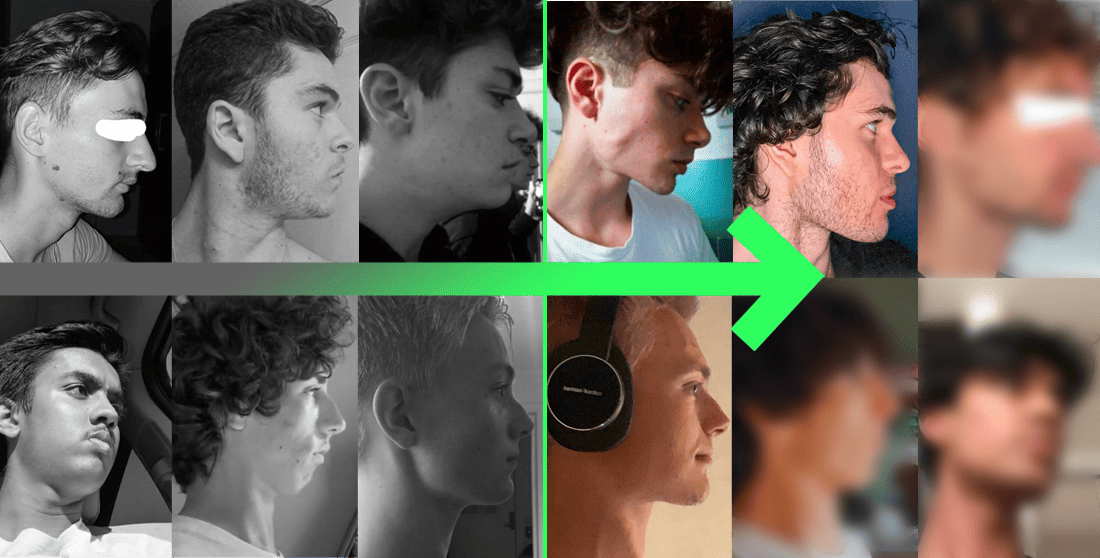
Mewing is a technique that focuses on proper tongue posture to improve facial structure and overall health. Invented in the 1970s, mewing gained mainstream attention only in the 2010s through viral videos and social media platforms. Mewing technique teaches you to place your tongue against the roof of your mouth, a simple act with profound health benefits.
When we trace back to its inception, we find it rooted in years of anatomical observation and research, rather than a fad that emerged overnight. Understanding the origins of mewing offers invaluable insights into why the method remains neglected and is a crucial part of any proper explanation of mewing.
Who are John & Mike Mew?
An orthodontist named John Mew started his inquiry into oral posture in Germany during the late 1960s and 1970s. At that time, Wolff’s Law of bone formation was widely recognized in Germany, stating that bones adapt to the stresses placed on them. We might pinpoint this as the earliest origin of the idea of mewing today.
Another influential concept was Melvin Moss’s Functional Matrix Theory, which posits that bones do not grow independently but are formed by surrounding soft tissues. John Mew applied these theories to the jawline, facial bones, and teeth, suggesting that altering your habits and training facial muscles can change the form of your jawline.
After decades of study, John Mew published a groundbreaking paper in the British Dental Journal in 1981. His paper showed that proper tongue posture is crucial for a well-defined jaw and aligned teeth. The orthodontic industry initially rejected his conclusions because adopting his approach goes against traditional care practices that view surgery and mechanical devices as the only option.
Mike Mew, John’s son, also entered the field of orthodontics and faced similar challenges. He qualified as a dentist in 1993 and focused on the interplay between posture, muscle function, and orthodontic issues. Now a lecturer and lead clinician at the London School of Facial Orthotropics, Mike Mew continues his father’s work, emphasizing the importance of orthotropics and mewing.
Both John and Mike Mew have contributed significantly to the realm of orthotropics. John Mew developed the Biobloc system, which begins with palate expansion and continues with posture techniques. Their combined efforts have authored textbooks and published international articles, emphasizing that traditional braces and surgery can negatively affect facial growth.
The term “mewing” itself was coined by online communities that adopted the orthotropic principles to enhance their jawlines. Today, thanks to the tireless work of John and Mike Mew, mewing has risen to mainstream attention since 2019, bringing countless positive outcomes in its wake.
Definition of Orthotropics
Orthotropics is a specialized branch of dentistry focused on treating teeth and jaw misalignment (malocclusions) by correcting oral and head posture. Unlike traditional orthodontics, which relies on mechanical procedures and surgery, orthotropics treats the biological root of malocclusion. The goal is to guide the forward growth of the upper and lower jaw, ensuring optimal rest oral posture.
This treatment often involves a three-phase process: preparation, training, and active retention, and usually takes approximately 36 months to complete. In contrast, orthodontics primarily focuses on straightening misaligned teeth through mechanical means like braces and tooth extractions. If we compare orthotropics vs orthodontics, the latter is more risky and may lead to jaw surgery later in life.
It is because orthodontics leans heavily on mechanical interventions for teeth and tongue alignment, while orthotropics adopts a more holistic approach aimed at natural facial growth. The latter is particularly effective in preempting the need for more invasive treatments, like jaw and teeth surgery.
Mewing aligns closely with the core objectives of orthotropics. It encourages proper oral posture to guide jaw and face growth, emphasizing natural, non-surgical methods. In essence, mewing is the practical application of orthotropics and serves as its pinnacle.
John and Mike Mew’s roles in popularizing orthotropics and mewing can’t be overstated. Their work challenges the established view of the dental community, pushing for a more natural, less surgical approach to orthodontics. No wonder it reached a mainstream audience, popularizing specialized medical practices for a larger public.
The Future of Mewing
Mewing is a topic of debate within oral care circles now, but at least some aspects of mewing will gain general acceptance. It’s only a matter of time. The practice shows promise in online testimonials and other evidence, which must drive the medical community to start rigorous testing sometime soon.
The same story of denial and later acceptance is applicable to many scientific theories and problems. Take the theory of evolution as an example. Initially met with skepticism, rigorous scientific investigation eventually validated it half a century later. Like evolution, if mewing stands up to scientific scrutiny, it will gain acceptance.
The fact that millions engage in mewing and achieve noticeable results cannot be ignored. This widespread practice and its documented effects make a compelling argument for its eventual acceptance. As science advances, practices that hold true find their rightful place in medical understanding, and mewing is no exception.
Of course, just as with evolution, there still are some deniers. But there is a point in the future where the general consensus will shift. That’s why it’s important to start mewing with innovative techniques and be ahead of the trends in the oral health industry.
With customizable reminders, video tutorials, mewing results tracking, and personalized exercises. Our Mewing.coach app is exactly the tool for this purpose. It will transform your habits to help you transform your face into an attractive and healthy shape.
Common Misconceptions about Mewing Technique
Misconceptions often arise due to incomplete information or misunderstandings of complex topics. Mewing, grounded in orthotropics, is no exception to this phenomenon. These misconceptions overlook the comprehensive nature of mewing, rooted in orthotropic principles, which focus on long-term teeth alignment and structural integrity of the face and jaw.
Mewing Is Just Tongue Placement
Many believe mewing is solely about tongue placement against the roof of the mouth. While tongue posture is integral and crucial, it’s not the entirety of the practice. Mewing also involves correct jaw alignment and nasal breathing, which aligns with orthotropic principles of face growth and oral posture.
Mewing Can Provide Quick Results
Another misconception is that mewing is a one-time adjustment rather than a continuous habit. This idea contradicts the orthotropic roots of mewing, which emphasize long-term oral and facial posture for lasting results. The habit of mewing regularly is essential for sustained benefits in jaw alignment and overall facial structure.
You Can Ignore Body Posture While Mewing
Some people believe that your face can be improved while neglecting the rest of your body. While this is true to an extent, for mewing to be really effective, you must care not only about how your tongue is placed but also about your body posture overall.
It would be naive to think that mouth and face exercises can improve while the rest of your body is stagnating. You must also achieve good body posture, exercise, sleep, and eat well.
Is Mewing Credible? Evidence of Mewing Effectiveness For Health and Looks
While there is a lot of theoretical justification from mewing experts, such as John and Mike Mews, it is a practice that’s better demonstrated than theoretically argued about. The image below presents improvements in looks but also in health, showing the orthotropic principles that mewing implements in action.

The mewing progression is especially evident in the jawline and facial symmetry, which shifted from a less defined, somewhat recessed appearance to a more pronounced and angular form. This not only enhances physical attractiveness but also signifies a well-aligned jaw, fulfilling one of the key objectives of mewing.
The disappearance of the double chin is another noteworthy change. A double chin often indicates poor oral posture and can be linked to various health issues, including excessive mouth breathing. Its absence in the after photo suggests the individual has transitioned to healthier nasal breathing, aligning with the goals of both mewing and orthotropics.
Wrapping Up
British Orthodontist John Mew and his son Mike Mew are rightfully credited as the inventors and main propagators of mewing. They dedicated years of study to formulate and popularize mewing.
Millions of people are already reaping the benefits of mewing to solve their problems. Compared to orthodontics, it is noninvasive for the jaw and low risk for overall health.




